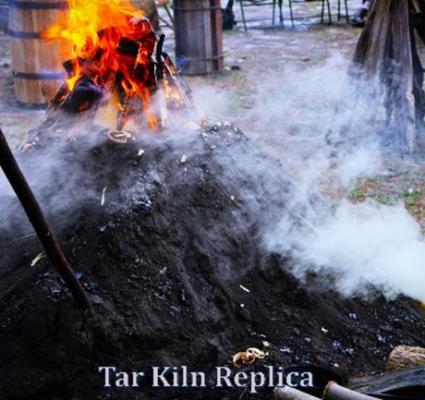Author: Steven Roberts; Moores Creek National Battlefield
In the heart of colonial North Carolina, beneath the towering longleaf pines, an industry flourished—one that kept the mighty British fleet afloat and expanded the empire’s reach across the seas. Naval stores—tar, pitch, turpentine, and rosin—were the lifeblood of maritime supremacy, sealing wooden ships against the ravages of salt and storm. Yet, behind this booming trade lay a grim reality: the brutal toil of enslaved Africans and poor white laborers who endured misery to fuel the empire’s ambitions.
The Rigors of Production

North Carolina’s vast longleaf pine forests made it a global supplier naval stores, but extracting these materials was sheer agony.
Beneath an unrelenting sun, laborers hacked into towering pines, their blades biting deep into the flesh of the trees to extract resin. Others worked in close proximity to the smoldering tar kilns, where thick, acrid smoke clung to their lungs, leaving them gasping, eyes stinging, and skin eternally stained with the black residue of their labor. Each breath carried the sting of burning sap, and each day pushed their bodies further toward exhaustion.
Enslaved Africans bore the worst of these conditions, condemned to ceaseless labor with no hope of reprieve. Their days stretched into endless torment; each movement dictated by overseers whose whips ensured compliance. Poor white workers, bound by debt or indentured servitude, were scarcely freer than their enslaved counterparts, shackled not by chains but by poverty itself. Tar seeped into their skin and hair, marking them permanently. To the world, they were little more than cogs in an unfeeling machine.
The Origins of "Tar Heel"
It was this toil—the relentless wading through tar-coated earth—that birthed the term "Tar Heel." First used as mockery, the phrase painted North Carolinians as backwoods laborers forever drenched in the sticky remains of their work. But over time, North Carolinians seized the insult and reshaped it into a badge of honor. Now, "Tar Heel" stands as a symbol of resilience, a tribute to those who endured and persevered despite impossible odds.
Economic Gain at a Human Cost

Though North Carolina’s naval stores fueled prosperity, the wealth flowed in one direction: upward.
Planters and merchants reaped the rewards, building their fortunes on the backs of those who suffered behind the scenes. Enslaved workers remained trapped in bondage, their sweat enriching enslavers who saw only profit. Poor white laborers clawed for survival, hemmed in by debt, disease, and the ever-present threat of ruin.
This industry, while sustaining colonial trade, left deep scars—physical, economic, and moral. The ships that carried British power across the seas were held together by suffering.
Legacy and Reflection
The story of naval stores production is not merely one of economic success; it is a tale of endurance, hardship, and survival. Recognizing the struggles of those who worked the pine forests shines a light on a history often overshadowed by commerce, revealing not just the ambition of an era, but the humanity of those who built it.
For those eager to explore this history firsthand, Moores Creek National Battlefield offers insight into this legacy. Visitors can walk the ¼-mile "Tar Heel" Trail, tracing the footsteps of those who labored in the pine forests. Located in Currie, North Carolina, just 23 miles northwest of Wilmington, the park grounds are open daily from 9 AM to 5 PM, with the visitor center accessible Tuesday through Saturday. More information can be found at www.nps.gov/mocr.

